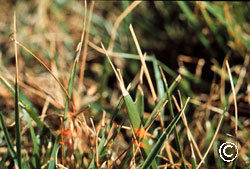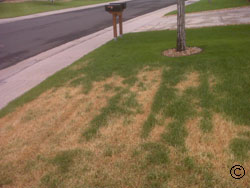Adapted by Jane Rozum, Douglas County Extension, from the CO-Horts blogoriginally authored by Tony Koski, Extension Turf Specialist.
What is ascochyta leaf blight?
 Stress resulting from hot, dry summer conditions increases the potential for Ascochyta leaf blight on lawns. This disease is common when cool weather (like May – June conditions) is followed by hot summer conditions. Ascochyta leaf blight is most severe when turf is stressed due to high heat and improper irrigation – insufficient amount, improper frequency, or poor coverage.
Stress resulting from hot, dry summer conditions increases the potential for Ascochyta leaf blight on lawns. This disease is common when cool weather (like May – June conditions) is followed by hot summer conditions. Ascochyta leaf blight is most severe when turf is stressed due to high heat and improper irrigation – insufficient amount, improper frequency, or poor coverage.
How do I know if my lawn has ascochyta leaf blight?
Brown wheel-tracks and footprints may appear in areas where mowing or foot traffic cause additional stress. This may lead to the incorrect assumption that the disease has been “tracked” onto the lawn from another location. The disease can be diagnosed by examining individual leaves (grass blades) that die back from the tip. Affected leaves are bleached and pinched in appearance and the entire leaf may die back to the ground. Severe infections may cause large straw colored patches to appear in the lawn, usually in areas where irrigation coverage is poor.
How can I prevent ascochyta leaf blight?
 Fortunately, this disease rarely kills turf, as the crown and root system are usually not affected by the disease. However, prolonged stress due to poor irrigation coverage may cause a loss of turf. Consistent and correct watering, repair of malfunctioning irrigation equipment or a soaking rain will encourage the turf to recover, a process which may take 10 days to 3 weeks. More rapidly growing grasses such as tall fescue and perennial rye grass will recover more quickly than will the slower-growing bluegrasses and fine fescues. Fungicide use does not seem to accelerate turf recovery. Applying adequate moisture, without irrigating the recovering turf excessively, will encourage turf recovery.
Fortunately, this disease rarely kills turf, as the crown and root system are usually not affected by the disease. However, prolonged stress due to poor irrigation coverage may cause a loss of turf. Consistent and correct watering, repair of malfunctioning irrigation equipment or a soaking rain will encourage the turf to recover, a process which may take 10 days to 3 weeks. More rapidly growing grasses such as tall fescue and perennial rye grass will recover more quickly than will the slower-growing bluegrasses and fine fescues. Fungicide use does not seem to accelerate turf recovery. Applying adequate moisture, without irrigating the recovering turf excessively, will encourage turf recovery.



